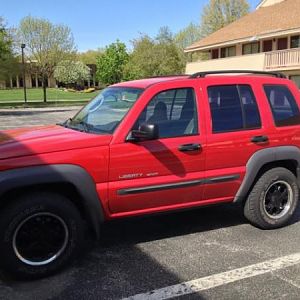I'll share what's going on, and if anyone has anything to contribute I will be most grateful.
Back ground:
1. 2003 Jeep Liberty Sport 4WD 3.7L
2. Blew a ring and trashed the engine
3. Had a Goodyear shop (excellent credentials, and past personal experience with them so I trust them) install a reman according to VIN and everything runs nice and smooth... until the PCM throws a P0304, Cylinder 4 misfire
4. The mileage between tripped codes, always P0304, varies between 12 and 110 miles.
5. The one pattern I noticed is that it seems to happen after the vehicle has been idling warm for 4+ minutes.
6. If I simply erase the stored P0304 code with an Antec diag handheld, the code resurfaces again somewhere between 20 and 40 miles, but only after I idle at a long light or pulled over in park.
7. When I detach the neg battery cable it seems to go 60+ miles before the p0304 code gets thrown.
8. When the code gets thrown I have to reset the PCM or the engine starts to run badly. I've got about $10k into the motor and the exhaust system, so I am not at all willing to risk blowing another motor.
Engine parts status:
1. New engine. 2 conversations with a TriStar engineer after all of the following was done, and I'm 99.7% confident that the motor is good. When the PCM isn't complaining it runs like a sewing machine.
2. The shop checked all vitals and everything is dead on spec (compression, fuel trim, everything)
3. All new coils, injectors, NGK Plat plugs
4. Complete exhaust system replacement, 3 new cats and pipe end2end
4. Eventually ran two bottles of Techron Complete fuel system cleaner through the tank as directed
5. Then ran one bottle of LiquiMoly Ceratec through the tank as directed
6. All original sensors were reused (the reman didn't include that and the shop didn't ask... so the MAP, TPS, IAC, IAT, etc are all in transit as I type this), and will be replaced by an auto electronics expert at another good shop I've used (time for new eyes)
7. The electrical harnesses are all original, and yes there is evidence of age, but no shorts have been detected by the 1st shop. We'll see what shop #2 says.
One last observation: I've got a concern that the existing wiring may be experiencing electromagnetic interference. I am no electronics expert but I had a problem in my man-cave with (a) unshielded signal wires being crossed over each other, and other wires being near electromagnetic coils in DC motors and past strong fluorescent lights... and I wonder if there may be any experiences out there regarding rogue EMI.
Back ground:
1. 2003 Jeep Liberty Sport 4WD 3.7L
2. Blew a ring and trashed the engine
3. Had a Goodyear shop (excellent credentials, and past personal experience with them so I trust them) install a reman according to VIN and everything runs nice and smooth... until the PCM throws a P0304, Cylinder 4 misfire
4. The mileage between tripped codes, always P0304, varies between 12 and 110 miles.
5. The one pattern I noticed is that it seems to happen after the vehicle has been idling warm for 4+ minutes.
6. If I simply erase the stored P0304 code with an Antec diag handheld, the code resurfaces again somewhere between 20 and 40 miles, but only after I idle at a long light or pulled over in park.
7. When I detach the neg battery cable it seems to go 60+ miles before the p0304 code gets thrown.
8. When the code gets thrown I have to reset the PCM or the engine starts to run badly. I've got about $10k into the motor and the exhaust system, so I am not at all willing to risk blowing another motor.
Engine parts status:
1. New engine. 2 conversations with a TriStar engineer after all of the following was done, and I'm 99.7% confident that the motor is good. When the PCM isn't complaining it runs like a sewing machine.
2. The shop checked all vitals and everything is dead on spec (compression, fuel trim, everything)
3. All new coils, injectors, NGK Plat plugs
4. Complete exhaust system replacement, 3 new cats and pipe end2end
4. Eventually ran two bottles of Techron Complete fuel system cleaner through the tank as directed
5. Then ran one bottle of LiquiMoly Ceratec through the tank as directed
6. All original sensors were reused (the reman didn't include that and the shop didn't ask... so the MAP, TPS, IAC, IAT, etc are all in transit as I type this), and will be replaced by an auto electronics expert at another good shop I've used (time for new eyes)
7. The electrical harnesses are all original, and yes there is evidence of age, but no shorts have been detected by the 1st shop. We'll see what shop #2 says.
One last observation: I've got a concern that the existing wiring may be experiencing electromagnetic interference. I am no electronics expert but I had a problem in my man-cave with (a) unshielded signal wires being crossed over each other, and other wires being near electromagnetic coils in DC motors and past strong fluorescent lights... and I wonder if there may be any experiences out there regarding rogue EMI.
















